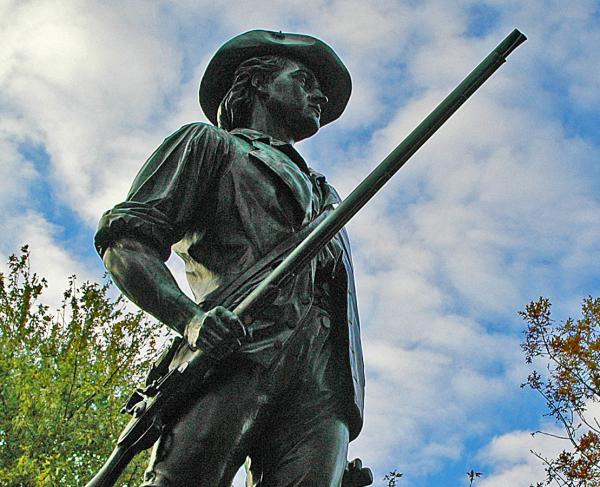
The Minute Man by Daniel Chester French, Minute Man National Historic Park, Middlesex County, Mass.
Limit Airport Expansion Near Lexington & Concord
Update
The National Trust for Historic Preservation, a nationwide nonprofit whose mission is the preservation of key sites from American history, has declared that Wilderness Battlefield is one of the 11 most endangered historic sites in the country due to the proposed Wilderness Crossing development.

The 11 Most Endangered Historic Sites list has been used since 1988 to raise awareness about critical threats to our nation's cherished places. Receiving this listing both highlights the danger the battlefield faces and shows the broad base of support for saving the battlefield which exists across the preservation community. Learn more here.
The Background
Minute Man National Historical Park is well known as the site of the famed “shot heard ‘round the world,” the opening shot of the Battles of Lexington and Concord, April 19, 1775, that sparked the American Revolutionary War. Today, however, visitors to the site are more likely to hear the roar of aircraft engines from nearby Hanscom Field, the busiest general aviation airport in New England. In fact, the facility handles more flights than any airport in the region, besides Boston’s Logan International Airport. A new proposal threatens to make the airport’s noise pollution more intrusive of the park visitor experience than ever before.
Hanscom Field lies immediately north of Minute Man National Historical Park, and some of its most significant features, such as the Revere Capture Site, Hartwell Tavern, Elm Brook Hill (Bloody Angle) and the North Bridge are all directly in the flight paths for take-off and landing. The airport’s impact on the park and other surrounding historic sites has long been contentious, with a previous update landing the park on the National Trust for Historic Preservation’s annual list of the nation’s most endangered sites in 2003.
According to an analysis of 18 months of flight data by the Institute for Policy Studies, half of Hanscom’s flights are made by private jets for recreational and luxury travel. Increasing demand in this sector has led to a proposal that would add a half-million square feet of impervious infrastructure, including 17 new hangars, to the facility. Proponents claim that the buildings would cut down on the need for “ferry flights” to other long-term storage facilities because more planes could be permanently based out of Hanscom. But opponents point out that with the capacity to store up to 76 new aircraft, thousands of additional recreational flights may be added.
A host of entities have expressed serious concerns about the expansion, ranging from the Select Boards of surrounding towns Bedford, Concord, Lexington and Lincon to the Massachusetts Historical Commission, Minute Man National Historical Park and numerous community and environmental organizations. They cite a host of objections that range from noise and visual intrusions to vehicular traffic to air quality and other environmental concerns. In particular, they say, claims that the total number of flights would decrease requires further explanation and guarantee.
The American Battlefield Trust joins these entities in the belief that this proposed expansion stands to cause further detriment to the battlefield and degradation of the visitor experience with sound pollution, air quality decrease and traffic congestion within the battlefield park. We are deeply concerned that the Draft Environmental Impact Report included a study area limited to resources less than one-quarter mile from the project site, meaning that no material consideration was given to the impact on the battlefield and national park. Such a limited study does not allow for adequate analysis of cumulative visual, atmospheric and audible effects of flight traffic on the park. This is counter to Section 106 of the National Historic Preservation Act which specifies "adverse effects may include reasonably foreseeable effects caused by the undertaking that may occur later in time, be farther removed in distance or cumulative."
How You Can Help
- The public comment period on the Draft Environmental Impact Report is open until June 14. Signing this petition will enable the Trust to help ensure your voice is included in the comments that are conveyed to state agencies and the developer.
- Consider making a gift to support the Trust's advocacy work to protect Lexington and Concord, as well as other battlefields across the nation.


